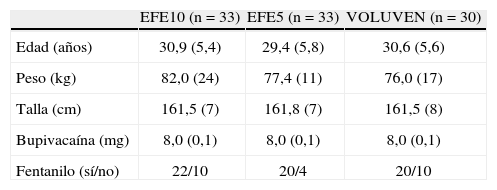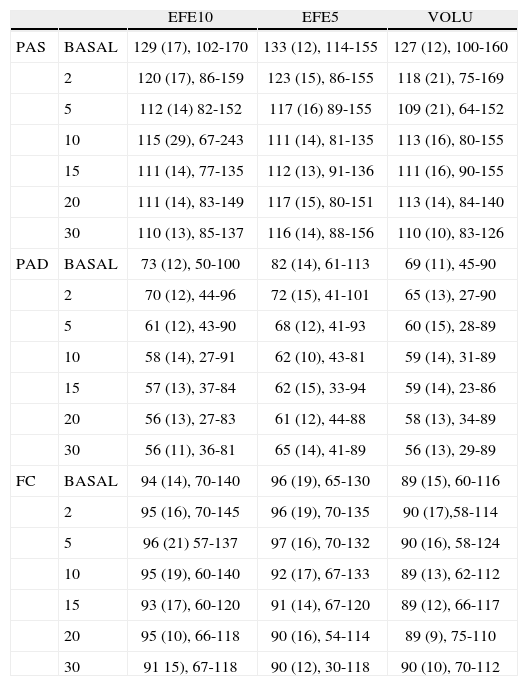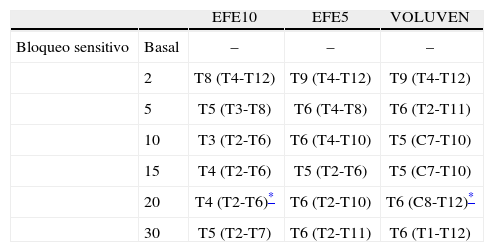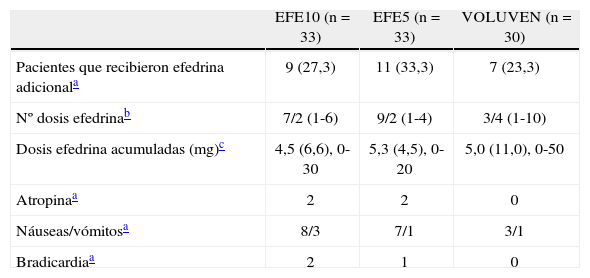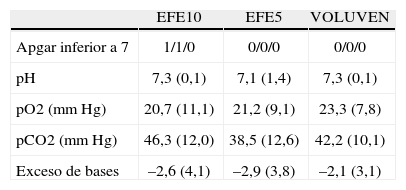Spinal anesthesia is the technique of choice for scheduled or emergency cesarean section, but the prevalence of hypotension is high in this setting. Our aim was to compare the efficacy of a colloid (6% hydroxyethyl starch [HES] 130/0.4) to ephedrine for preventing hypotension.
Patients and methodsPatients undergoing elective or emergency cesarean section (in non-life-threatening situations) were enrolled. Patients were randomized to 3 groups for prophylaxis. The first ephedrine group received 5mg of ephedrine intravenously (EPHE-5); the second ephedrine group received 10mg of the drug intravenously (EPHE-10); and the HES group received 500mL of HES 130/0.4 in rapid infusion in 15minutes. We recorded systolic and diastolic blood pressures and heart rate after 10minutes in the operating room and 2, 5, 10, 15, 20, and 30minutes after injection of the anesthetic. We also assessed the sensory and motor blockades on both sides 2, 5, 10, 15, 20, and 30minutes after injection. Neonatal status was assessed by Apgar score and umbilical cord blood gas analysis.
ResultsNinety-six patients, 33 in each ephedrine group and 30 in the HES group, were enrolled. Blood pressure decreased similarly in all 3 groups (36% EPHE-5 group, 36% EPHE-10 group and 40% HES group); no significant between-group differences were observed. Nor were there significant differences in the percentages of patients requiring bolus doses of ephedrine to treat hypotension (23% in the HES group vs 33% in the EPHE-5 group and 27% in the EPHE-10 group) or in the cumulative doses of ephedrine. Neonatal status was also similarly satisfactory in all 3 groups.
ConclusionsHES 130/0.4 is as useful for hypotension prophylaxis as 5-mg or 10-mg intravenous doses of ephedrine. HES 130/0.4 might be a substitute for sympathomimetic agents if adverse effects are predicted or contraindications to the use of such drugs are present.
La anestesia subaracnoidea es la técnica de elección para la intervención de cesárea, tanto electiva como urgente y la hipotensión arterial secundaria tiene una alta prevalencia. El objetivo de nuestro trabajo fue valorar la eficacia de un coloide hidroxietilalmidón 6% 130/0,4 y comparar su eficacia con la de la efedrina para la prevención de la hipotensión arterial.
Pacientes y métodosSe incluyeron pacientes sometidas a cesárea electiva o a cesárea urgente no vital. Se distribuyó a las pacientes en tres grupos de profilaxis: grupo EFE 5, efedrina 5mg iv; grupo EFE 10, efedrina 10mg iv; grupo VOLU, hidroxietilalmidón 130/0,4, 500mL en perfusión rápida en 15min. Se registraron presión arterial sistólica, diastólica y frecuencia cardiaca a los 10min de entrar en el quirófano, así como a los 2, 5, 10, 15, 20 y 30min de inyectado el anestésico. Se valoró el bloqueo sensitivo y motor bilateralmente a los 2, 5, 10, 15, 20 y 30min después de la anestesia. Se valoró el estado de los recién nacidos según el test de Apgar y gasometría venosa umbilical.
ResultadosSe incluyeron 96 pacientes (33 grupo EFE5, 33 grupo EFE10, 30 grupo VOLU). No se hallaron diferencias significativas en las presiones arteriales entre los distintos grupos de profilaxis, con descenso similar en los grupos de estudio (36% grupo EFE 5, 36% grupo EFE 10 y 40% grupo VOLU). No hubo diferencias significativas en el número de bolos de efedrina necesarios para el tratamiento de la hipotensión arterial (23% de las pacientes en el grupo VOLU, frente al 33% en el grupo E5 y el 27% en el grupo E10), ni las dosis acumuladas de efedrina. No se apreciaron diferencias significativas en el resultado neonatal, que fue adecuado en todos los neonatos.
ConclusionesLa profilaxis de la hipotensión arterial con (HEA) 130/0,4 es tan útil como la porporcionada por 5 o 10mg de efedrina iv. Podría estar indicada, en lugar de los fármacos simpaticomiméticos, si se prevé efectos adversos o si existen contraindicaciones de los mismos.
Artículo
Comprando el artículo el PDF del mismo podrá ser descargado
Precio 19,34 €
Comprar ahora






